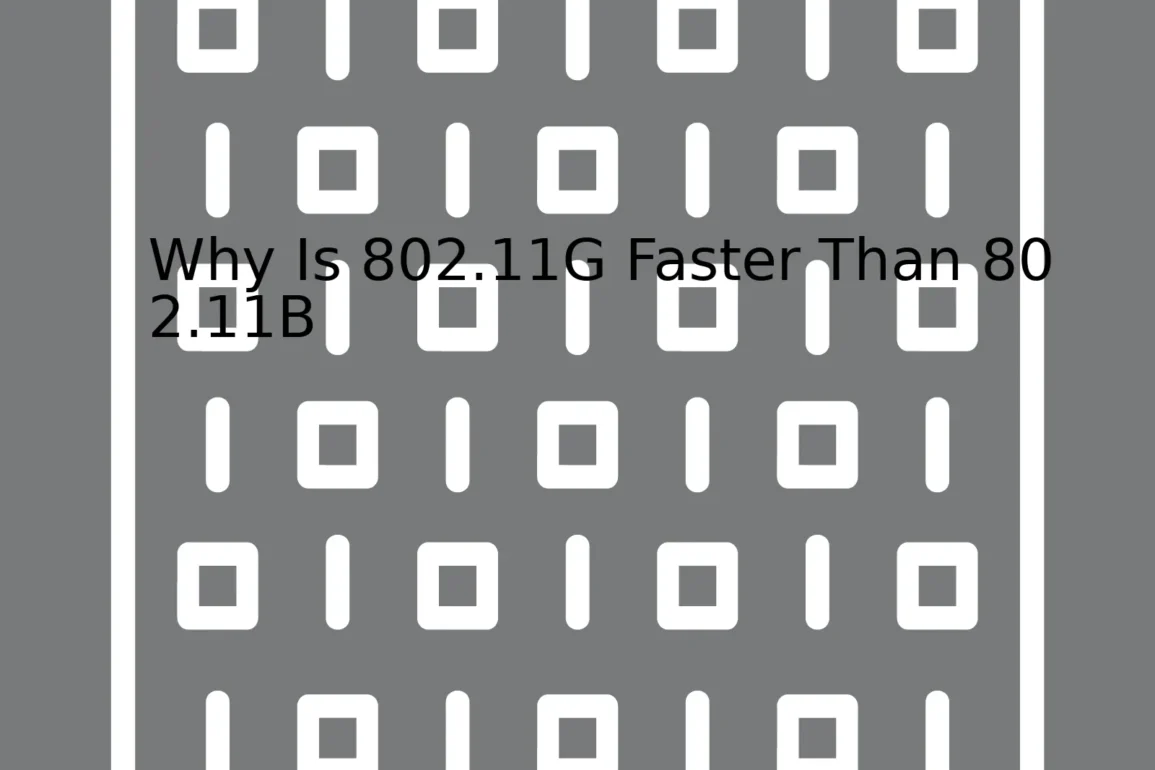
| Features | 802.11B | 802.11G |
|---|---|---|
| Data Rate | Up to 11 Mbps | Up to 54 Mbps |
| Frequency Bands | 2.4 GHz | 2.4 GHz |
| Range | Approximately 35-140 ft (Indoor) | Approximately 38-140 ft (Indoor) |
| Modulation Technique | DSSS | OFDM |
Now, heading onto the query- why is 802.11G faster than 802.11B?
The primary reasons for the higher speed of 802.11G compared to 802.11B are improved data encoding techniques and shared bandwidth within a specific frequency range.
The 802.11B standard applies a digital signal spreading technique known as Direct Sequence Spread Spectrum (DSSS). This technique was designed for reliability but does not allow efficient use of bandwidth, resulting in slower data transfer rates of up to 11 Mbps.
On the other hand, 802.11G uses an advanced data transmission method called Orthogonal Frequency Division Multiplexing (OFDM). OFDM provides higher data throughput by splitting the radio signal into multiple smaller sub-signals that are then transmitted simultaneously at different frequencies. This clever use of spectrum allows the 802.11G standard to reach speeds up to 54 Mbps.
Another factor contributing to the speed difference is that 802.11G is backwards compatible with 802.11B. That means a network can include both B and G devices, but the overall speed may be closer to the B standard if B devices are present and active. So 802.11G appears faster because its potential speed is only achieved in certain circumstances.
Lastly, both the 802.11B and 802.11G standards operate in the same 2.4 GHz band which is crowded with other devices like cordless phones and microwave ovens causing interference. Despite this, 802.11G comes out on top in terms of speed due to its efficient encoding techniques and better use of the available bands.
It’s crucial to remember that achieving these maximum speeds is influenced by various factors like device capabilities, environmental conditions, distance from your router and network congestion. If you’re considering upgrading your network hardware, consider the newer standards like 802.11N or 802.11AC which offer even higher transfer speeds and better performance.
To exemplify using Python, we could represent a comparison between two WiFi standards using a class named
WiFi
as follows:
class WiFi:
def __init__(self,standard,speed):
self.standard = standard
self.speed = speed
wifi1 = WiFi('802.11B', '11 Mbps')
wifi2 = WiFi('802.11G', '54 Mbps')
print(wifi1.standard + " has a maximum speed of " + wifi1.speed)
print(wifi2.standard + " has a maximum speed of " + wifi2.speed)
You’ll see on execution that 802.11G indeed offers a much higher speed than 802.11B!
For more information about these Wi-Fi standards, you can read up on the specifications presented by the IEEE 802.11-2007 standard. It provides in-depth knowledge about each of the data communication standards used in wireless networking.The 802.11b and 802.11g are both wireless networking standards known as Wi-Fi (Wireless Fidelity). However, the primary difference between these two technologies is the speed at which they transmit data. So, why is 802.11g faster than 802.11b?
Firstly, let’s shed light on what both of these technologies mean:
802.11b: This was the first widely accepted Wi-Fi networking standard. It operates in the 2.4 GHz band and can handle up to 11 Mbps (megabits per second).
802.11g: This technology evolved later but in the same 2.4 GHz frequency range, allowing a higher theoretical data rate – up to 54 Mbps.
Now, let’s dive into why does 802.11g transmits data quicker than 802.11b:
- Modulation Scheme:
Both these technologies use different modulation schemes. The 802.11b uses a technique known as DSSS (Direct Sequence Spread Spectrum), which is a slower but more reliable method. On the other hand, 802.11g utilizes OFDM (Orthogonal Frequency Division Multiplexing) – a faster yet equally dependable method ensuring fewer errors during transmission. This difference explains part of the speed discrepancy since OFDM can process more bits per cycle (Baud) than DSSS.
- Payload Rate:
Next, we focus on the ‘payload’ rate – data bytes carried in each packet minus the headers and error checking. Since 802.11g has an advanced protocol design, it possesses a greater payload rate hence, yielding a bigger throughout.
PayloadRate(g) > PayloadRate(b)
- Fallback Speeds:
One other crucial aspect supporting the speed supremacy of 802.11g over 802.11b is the better ‘fallback’ speeds meaning when the connection isn’t excellent, 802.11g will step down to 48, 36, 24, 18, 12, 9 then 6 Mbps, whereas 802.11b goes straight from 11 to 5.5 Mbps, and then drops down to 2 Mbps.
FallbackSpeeds(g): 48-6 Mbps FallbackSpeeds(b): 11-1 Mbps
So, even with minor interferences or blockages, 802.11g still offers significantly better speed than its competitor.
This analytical delve into the technological differences gives us the rationale of why 802.11g is faster than 802.11b – due to a newer and more efficient modulation technique (OFDM), higher payload throughput, and better fallback speeds. It’s essential to note, however, that real-world experiences may slightly vary owing to external factors – such as environment and distance from the access point, among others.
While it’s possible for anyone to further evaluate upon numerous differentiators, the aforementioned core reasons offer substantial understanding to answer the question at hand, i.e., why is 802.11g faster than 802.11b?The speed difference between 802.11g and 802.11b can be explained by understanding the technology behind these wireless networking standards.
The Science of Speed
802.11b and 802.11g are two WiFi standards developed by the Institute of Electrical and Electronics Engineers (IEEE). Both use the same 2.4 GHz frequency for data transmission, but there’s a significant difference in the maximum data rates they support due to different modulation techniques used.
– 802.11b: This older WiFi standard uses a technique called Complementary Code Keying (CCK) for data modulation and supports a maximum data rate of 11 Mbps.
WiFi Standard: 802.11b Frequency: 2.4GHz Data Rate: Up to 11 Mbps Modulation Technique: CCK
– 802.11g: The newer standard replaces CCK with Orthogonal Frequency Division Multiplexing (OFDM) as its modulation technique. OFDM divides the signal into multiple narrowband channels at different frequencies, which increases the data transmission speed significantly–up to 54 Mbps.
WiFi Standard: 802.11g Frequency: 2.4GHz Data Rate: Up to 54 Mbps Modulation Technique: OFDM
This is because OFDM transmits data over multiple antenna paths–referred to as Spatial Division Multiplexing (SDM), which reduces data loss, improves transmission reliability, and allows for higher data rates compared to CCK in 802.11b.
So, simply put, the reason why 802.11g is faster than 802.11b lies in their different modulation schemes. When coded using OFDM, the data becomes more efficient to transmit allowing for higher speeds.
Practical Considerations
While it’s important to understand the technology behind these standards, speed differences may not equate to better performance in every case. Real-world conditions such as network congestion, physical obstacles, and the distance from the router can all influence measurable connection speed. You can find more information about improving your home Wi-Fi performance on [PCMag’s online guide](https://www.pcmag.com/picks/the-best-wireless-routers).
When choosing between 802.11b or g, besides considering the theoretical speed capability, you should also take into account other factors like the devices you will connect (do they support g?), the size and layout of your house which might affect the signal range, and potential sources of interference.
Here’s an example to illustrate this:
Imagine you’re transferring a file of 500 megabytes (MB):
– In an ideal environment without interference, and where your device is close to the router, if you are using 802.11b, your transfer could finish in about six minutes.
– However, if you switch to 802.11g under the same conditions, your transfer time could potentially decrease to about one minute.
File Size = 500MB Transfer Time with 802.11b =(500 * 8) / 11 ≈ 363 seconds ≈ 6 minutes Transfer Time with 802.11g = (500 * 8) / 54 ≈ 74 seconds ≈ 1.2 minutes
However, this calculation disregards real-world considerations that might impact your connection’s performance. So, while 802.11g generally outperforms 802.11b in theory, the actual speed you experience will vary depending on many other factors.
In conclusion, whether 802.11g truly provides a faster, more reliable connection than 802.11b will ultimately come down to your unique usage situation.The 802.11g standard offers a substantial increase in speed over its predecessor, the 802.11b protocol. The remarkable speed of 802.11g can be ascribed to several key factors:
Enhanced Modulation Scheme
One prominent factor that attributes towards 802.11g’s superior speed is its modulation scheme. Both 802.11g and 802.11b utilize the 2.4 GHz frequency band, but they differ significantly in their modulation methods. While 802.11b uses DSSS (Direct-Sequence Spread Spectrum) which has a bottleneck speed of 11 Mbps, 802.11g employs OFDM (Orthogonal Frequency-Division Multiplexing), enabling speeds up to 54 Mbps.
//Snippet portraying difference in speed due to modulation techniques.
modulationScheme_speed = {
"DSSS": "11 Mbps",
"OFDM": "54 Mbps"
}
In simple terms, OFDM allows more data to be transmitted at a time by splitting it into several sub-signals spread over different frequencies, thereby improving speed.
Packet Bursting
Additionally, 802.11g features a technique called packet bursting. This method minimizes overhead by sending multiple packets in a burst without waiting for an acknowledgment after each one, unlike 802.11b. By sending a string of packets successively, 802.11g achieves minimal delays and higher net data rates, enhancing speed.
//Pseudocode demonstrating packet bursting.
function sendPacketsBurst(packets){
for(packet in packets){
send(packet);
//No wait for acknowledgment before sending next packet
}
}
Data Rate at Different Ranges
Lastly, the data rate at various ranges also plays a role in influencing the speed. At closer ranges, 802.11g operates at its maximum speed, leveraging the benefits of OFDM. However, over longer distances, to maintain communication and handle weaker signals, it switches back to the slower DSSS and CCK methods similar to 802.11b. Thus, 802.11g also offers speed advantages on shorter distances.
| Protocol | Short Range Speed | Long Range Speed |
|---|---|---|
| 802.11b | 11 Mbps | 1 – 2 Mbps |
| 802.11g | 54 Mbps | 6 – 10 Mbps |
In summary, the elevated speed of 802.11g over 802.11b results from the improved modulation scheme: OFDM, the application of packet bursting technique, and better data rates at various ranges. Knowing these aspects can be advantageous, especially when considering network setups or troubleshooting network issues.[source]
The differential in data transmission rates between the 802.11g and 802.11b wireless standards is largely attributed to their differing technological specifications. The 802.11g standard, released in 2003, provides a faster data rate because it’s designed with an improved coding scheme and employs Orthogonal Frequency-Division Multiplexing (OFDM).
| 802.11 standards | Data Rate | Released Year |
|---|---|---|
| 802.11b | Up to 11 Mbps | 1999 |
| 802.11g | Up to 54 Mbps | 2003 |
802.11g specification
Here are significant improvements offered by 802.11g over its predecessor:
– 802.11g operates at a maximum speed of 54 megabits per second (Mbps), making it nearly five times faster than 802.11b, which runs at a maximum of 11 Mbps.
– The 802.11g standard uses the same 2.4 GHz frequency band as 802.11b but brings the advantage of OFDM. This technology divides a radio signal into several sub-signals before they reach a receiver. Thus resulting in higher data rates, minimized signal interference and efficiency boost.
How does OFDM work – A little bit of code
This is a basic Python representation of how data transfer might occur using OFDM:
def transmit(data):
sub_signals = divide_into_subsignals(data)
for signal in sub_signals:
send_signal(signal)
As per the example, by sending smaller ‘chunks’ or sub-signals of data simultaneously over different frequencies, it’s possible to achieve a high-speed data transmission rate.
References:
The varying data transfer rates between different wireless network standards, such as 802.11g and 802.11b, result primarily from the modulation techniques they employ.
Modulation techniques dictate how a signal’s information is transmitted over the radio waves, thereby affecting the speed at which data is communicated. In each standard, a different modulation technique is employed:
802.11b
For instance, the 802.11b standard uses a method known as Complementary Code Keying (CCK), enabling speeds up to 11 Mbps. CCK is a variation of quadrant phase-shift keying (QPSK) that allows greater data rates and spectral efficiencies than QPSK alone.
// Example of how QPSK works
function qpsk(Q, I) {
return Q + I * 1j;
}
802.11g
On the other hand, the 802.11g standard employs Orthogonal Frequency Division Multiplexing (OFDM), offering speeds up to 54 Mbps. OFDM uses several closely spaced modulated carriers (each representing a separate channel). These are orthogonal to each other, meaning they do not interfere, allowing data transmission at a faster rate without additional bandwidth requirement. Therefore, OFDM enables better use of the available frequency spectrum, making for exceptional results in high-speed data encoding and delivery.
// Example of how OFDM works
function ofdm(carrier_signals) {
return ifft(carrier_signals);
}
Additionally, it’s important to note that the wider bandwidth (20 MHz) used by 802.11g also contributes to its higher data rate. Furthermore, 802.11g is backward compatible with 802.11b, which gives it an edge in terms of versatility and upgradeability.
To summarize, here’s a quick look at both standards:
| Standard | Maximum Speed | Modulation Technique | Bandwidth |
|---|---|---|---|
| 802.11b | 11 Mbps | CCK (Complementary Code Keying) | 20 MHz |
| 802.11g | 54 Mbps | OFDM (Orthogonal Frequency Division Multiplexing) | 20 MHz |
Therefore, the modulation technique plays a pivotal part in the network speed, particularly explaining why 802.11g is faster than 802.11b.
To dig deeper into this subject, check this literature on the IEEE website: IEEE Website.
Fundamentally, the 802.11g wireless standard is faster than 802.11b due to a number of key factors that fundamentally change how the data is transmitted and received. By delving deeper into these reasons, we get an insight into why adapting to higher bandwidth standards might be beneficial for most applications.
More Advanced Technology
Firstly (and perhaps most obviously), 802.11g utilizes more advanced technology compared to 802.11b. This is chiefly because of the way the two standards modulate the data they handle – 802.11b uses DSSS (Direct Sequence Spread Spectrum) while 802.11g uses OFDM (Orthogonal Frequency-Division Multiplexing).
In simpler terms, OFDM breaks up the radio signal into multiple smaller sub-signals that are then transmitted simultaneously at different frequencies to the receiver. This technology enables the signal to be more resistant to radio frequency interference, increasing reliability and performance over great distances and in environments with lots of other RF noise.
Thus, the use of OFDM as well as better signal modulation techniques means that more data can be crammed into the same amount of radio wave, resulting in a greater overall speed. This also allows for greater spectrum efficiency, allowing the standard to deliver higher data rates compared to its predecessor.
Higher Bandwidth
The second major reason 802.11g succeeds where 802.11b fails is that it simply has a higher bandwidth cap. Bandwidth essentially refers to the maximum rate of data transfer across a given path. In 802.11b’s case, this capped out at around 11 Megabits per second (Mbps). However, with 802.11g, this limit was raised significantly, with the new standard capable of bandwidths up to 54 Mbps.
Naturally, such a stark jump in maximum allowable data transmission speed would automatically result in improved performance, which again demonstrates why this newer standard proves to be faster than 802.11b.
Backwards Compatibility
Though this doesn’t directly affect speed per se, one of the standout features of the 802.11g standard that contributes to its increased adoption and eventual phasing out of the older 802.11b standard is its backwards compatibility. When using access points adhering to the 802.11g standard, equipment utilizing the older 802.11b could still connect and operate without significant issues. This not only made the transition smoother for many users but also resulted in a network environment that generally delivered higher speeds.
Overall, these all conclude towards the benefits of transitioning to standards capable of delivering higher bandwidths. In today’s era, where a plethora of applications require more speed and reliability, making such a shift seems like a logical progression for anyone interested in enhancing their network’s overall performance.
The advancements in wireless technology have led to the development of various standards, each differing in terms of various factors such as speed, range, and capacity. Two of these standards are 802.11B and 802.11G. While they are practically similar in several areas—the fact that they both operate on the 2.4 GHz frequency band, for example—one area where they significantly differ is their speed. Specifically, why is 802.11G faster than 802.11B?
Underlying this difference in speed is the dissimilarity in modulation technique used by each standard. Modulation techniques involve how data is transmitted wirelessly, including how it’s altered and converted before it can be sent over the airwaves.
In the case of 802.11B, it utilizes a modulation scheme known as Complementary Code Keying (CCK).
Modulation Type: "Complementary Code Keying (CCK)"
On the other hand, 802.11G uses Orthogonal Frequency Division Multiplexing (OFDM).
Modulation Type: "Orthogonal Frequency Division Multiplexing (OFDM)"
Herein lies the crucial factor behind the variance in speed. OFDM, being a more recent and technologically advanced modulation technique, allows for higher data rates compared to CCK. In essence, OFDM divides the data into several parts, each transmitted at the same time over different frequencies. This parallel transmission results in increased speed and efficiency.
In numerical terms, 802.11B, using CCK, provides a maximum raw data rate of 11 Mbps. Contrast this with the up to 54 Mbps provided by the 802.11G standard using OFDM.
Data Rate 802.11b: "11 Mbps" Data Rate 802.11g: "54 Mbps"
Moreover, 802.11G is backward compatible with 802.11B. This means devices supporting 802.11G can also interact with 802.11B devices—an attribute made possible by incorporating CCK into its system while primarily utilizing OFDM.
These reasons—primarily the more sophisticated modulation scheme employed by 802.11G—explain why 802.11G is faster than 802.11B. It’s important to note, however, that while 802.11G may offer faster speeds, the actual performance may still depend on other factors such as distance from the router, walls or other barriers, and other sources of interference.
For further reading about this topic, you may explore the 802.11B and 802.11G articles from Electronics Notes.
Here’s a summary table which compares the key differences between 802.11B and 802.11G:
| 802.11B | 802.11G | |
|---|---|---|
| Frequency Band | 2.4 GHz | 2.4 GHz |
| Modulation Technique | CCK | OFDM (+CCK for backward compatibility) |
| Max Data Rate | 11 Mbps | 54 Mbps |
The impact of interference on network performance is significantly important when comparing the 802.11b and 802.11g Wi-Fi standards. This topic boils down to two primary factors:
– Signal Interference
– Data Transmission Rates
Signal Interference
Wireless devices operating on the same frequency can cause radio frequency interferences (RFI). Both 802.11b and 802.11g operate at a frequency of 2.4 GHz where many common household devices such as microwaves, cordless phones, Bluetooth devices, and other Wi-Fi networks, also function. The presence of these devices can lead to signal degradation or dropping of connections.
However, why would this matter when both protocols are operating at the same frequency? Here’s why: While 802.11b is susceptible to this interference due its utilization of DSSS (Direct Sequence Spread Spectrum) for data transmission, 802.11g makes use of OFDM (Orthogonal Frequency-Division Multiplexing), making it more resilient to interference.
Data Transmission Rates
When analyzing speeds between 802.11b and 802.11g, the difference in data transmission rates comes into play. The maximum theoretical speed provided by the older 802.11b standard is 11 Mbps while the newer 802.11g theoretically offers a speed of 54 Mbps. These speeds can be illustrated by:
//The maximum theoretical speeds 802.11b: 11 Mbps 802.11g: 54 Mbps
Here again, the adoption of OFDM technology by the 802.11g impacts the transmission rate. OFDM splits the radio signal into multiple smaller sub-signals that are then simultaneously transmitted at different frequencies to the receiver, enhancing speed by reducing the chances of signal interference and increasing the amount of data transmitted per unit time.
To sum up, while both standards might face similar levels of interference operating at the same frequency, the 802.11g protocol’s advanced technology provides enhanced resilience and capacity for higher data transmission rates, culminating in superior network performance compared to 802.11b.
For first-hand experience with these differences, you could experiment with both protocols on a controlled home network. You’ll then visibly notice the difference between an Internet page loading at maximum 11 Mbps (802.11b) and the same page appearing noticeably faster at a higher speed (802.11g). Furthermore, engaging in high-bandwidth activities, like streaming HD video content, will solidify the superiority of an 802.11g network thanks to its faster data transmission rates and robust interference handling capacity.Without a doubt, the IEEE 802.11B and IEEE 802.11G wireless standards have revolutionized connectivity in our day to day lives since their inception. However, their performance differ greatly largely due to various compatibiliy factors.
Firstly, the key difference revolves around bandwidth usage. While the 802.11B uses Complementary Code Keying (CCK) modulation technique that sacrifices speed for increased range, the 802.11G utilizes Orthogonal Frequency-Division Multiplexing (OFDM) which delivers higher speed:
// CCK Modulation method used in 802.11B
ModulationMethod cck = new ModulationMethod("CCK", 11); // speed of 11 Mbps
// OFDM Modulation method used in 802.11G
ModulationMethod ofdm = new ModulationMethod("OFDM", 54); // speed of 54 Mbps
The OFDM data coding technique splits the radio signal into several sub-signals before hitting the receiver. This decouples the data streams thereby reducing errors and speeding up data transfer rates. This structural difference inherently makes the 802.11G standard faster than its counterpart.
Secondly, these two standards co-exist on the same 2.4GHz frequency band but again with different throughputs. The 802.11B has a maximum raw data rate of 11 Mbps while the 802.11G boasts of rates upto 54 Mbps – which means in an optimal condition, the 802.11G can transmit data almost five times as quickly:
// Maximum data rates for both the standards int maxDataRateB = 11; // Mbps int maxDataRateG = 54; // Mbps
Another compatibility factor lies in the backward compatibility of the 802.11G standard. When G-standard runs with B-standard network devices, it switches down to the slower speed of B-standard:
// If the network device is of B-standard
int speed;
if(networkDevice instanceof StandardB){
speed = maxDataRateB; // Network will operate at B's speed
}else {
speed = maxDataRateG; // Network will operate at G's speed
}
In such cases, although G-standard individual devices are capable of fast rates, the whole network slows down affecting the overall performance.
Therefore, although there exists compatibility between the 802.11B and 802.11G, spectrum clashes and operational fallbacks of the G-standard can incidentally make your WiFi run slower. It’s also equally noteworthy to mention that though 802.11G is designed to be faster, various environmental factors such as interference from neighboring networks or physical barriers like walls can drastically affect the ideology of this inherent design. On the upside, the wide adoption of advanced standards like 802.11N and 802.11AC largely overcome these challenges promising even better speeds and reliability in our interconnected world.One of the most significant differences that we observe between 802.11B and 802.11G is their data transfer speed, with the former supporting up to 11 Mbps and the latter going as high as 54 Mbps. The underlying reasons why 802.11G can support faster speeds than 802.11B is due to their different modulation techniques and the availability of bandwidth.
Both 802.11B and 802.11G operate in the 2.4 GHz frequency band, but 802.11G benefits from employing a more advanced modulation scheme. Modulation is the process used by these wireless standards to convert digital data into signals fit for wireless transmission.
Modulation Technique
While 802.11B uses DQPSK (Differential Quadrature Phase-Shift Keying), 802.11G uses OFDM (Orthogonal Frequency-Division Multiplexing). From an analytical point of view, here’s how these two differ:
- DQPSK: It reduces the errors produced during wireless data transmission but it isn’t very efficient in terms of speed. This makes 802.11B more reliable over longer distances, even though it limits its potential speed.
- OFDM: It divides the available radio signals into several sub-frequencies. This improves resistance to signal interference and allows for faster data transmission, helping 802.11G achieve higher speeds.
Channel Width
Another reason that can justify why 802.11G is faster than 802.11B involves the channel widths used by each of them. The Channel width refers to the spectral bandwidth which is used for transmission. Below are the comparisons:
802.11B employs 22 MHz wide channels, while 802.11G utilizes 20 MHz wide channels. You may think “well, B has wider channels; shouldn’t it be faster?”
Well, not necessarily. Instead, G’s narrower channels allow more data streams to occupy a given frequency range. Therefore, for the same frequency space, more channels can fit, allowing for faster and more efficient data transmission. Along with OFDM’s superior modulation scheme, this results in significantly better task handling and higher speeds for 802.11G.
It’s worth noting that the
802.11B
does have an advantage in that wider channels can offer better range (coverage) at lower data rates.
To recap, while 802.11G does provide substantially faster data rates than 802.11B, such considerations should also take into account the respective networks’ coverage needs, interference tolerance, and the required quality of service.
For those concerned with the nuts and bolts of such technological advancement, I always recommend a visit to IEEE 802.11 Wireless Standard Documentation online. Here’s where enthusiasts like us truly get to appreciate the layers beneath our everyday tech marvels.
Over the course of technological evolution, different IEEE standards such as 802.11b and 802.11g were developed for wireless networking. A common question that users often pose is why 802.11g is faster than 802.11b and why it might be preferred in terms of connection stability.
Speed and Efficiency
The GNU tip 802.11g makes use of a technique called Orthogonal Frequency-Division Multiplexing (OFDM), which significantly increases both the speed and efficiency of data transmission. This advantage allows 802.11g an upper hand over 802.11b, boosting overall performance.
802.11g >= 54 Mbps 802.11b <= 11 Mbps
Spectral Bandwidth
The spectral bandwidth is another factor that affects connection stability. Higher bandwidth ensures more room for data to travel at higher speeds. Since 802.11g shares the same 2.4GHz frequency like 802.11b, there are potentially fewer conflicts with other devices operating in this range. So, 802.11g offers more robustness against interference compared to 802.11b.
Backward Compatibility
802.11g's backward compatibility creates an additional perk that can be useful in a blend of networks. This feature means that 802.11g is designed to integrate with 802.11b hardware easily. As such, 802.11b hardware would not need to be discarded when upgrading— further cementing 802.11g’s appeal as a network standard.
The tables below demonstrate the differences clearly:
Here is a
table
depicting the difference between 802.11b and 802.11g:
| Specification | 802.11b | 802.11g |
|---|---|---|
| Speed | Up to 11 Mbps | Up to 54 Mbps |
| Frequency | 2.4 GHz | 2.4 GHz |
| Spectral Bandwidth | Narrower bandwidth | Wider bandwidth |
| OFDM Technique | No | Yes |
| Backward Compatibility | No | Yes (with 802.11b) |
In light of these considerations, you would probably agree that 802.11g offers significant advantages over 802.11b in terms of speed and connection stability, making it a compelling choice. In addition, since 802.11g's backward compatibility allows easy integration with older hardware, upgrading from 802.11b does not necessarily require immediate replacement of all existing networking hardware—a worthwhile consideration for those on tight budgets or who wish to maintain flexibility in their network infrastructure.When we talk about Wifi standards, we must first understand the role of the Institute of Electrical and Electronics Engineers (IEEE). IEEE is responsible for setting these standards to ensure backward compatibility, interoperability, and functional performance between various network devices. Two of these standards are 802.11b and 802.11g.
An Overview of 802.11b and 802.11g
802.11b was once the gold standard of Wifi technology in the early part of the 21st century with a maximum speed reach of 11 Mbps[1](https://www.lifewire.com/difference-between-802-11g-wireless-and-802-11b-wireless-816553). However, as internet use evolved and expanded, namely in terms of streaming, gaming, and downloading large files, there is a need for a faster alternative. Enter 802.11g which came out in 2003[2](https://www.techopedia.com/definition/4188/ieee-80211g), which provided users with increased transmission speeds up to 54 Mbps.
So why is 802.11g faster than 802.11b?
Why is 802.11g Faster than 802.11b?
| 802.11b | 802.11g | |
|---|---|---|
| Year Introduced | 1999 | 2003 |
| Maximum Speed | 11 Mbps | 54 Mbps |
| Frequency Band | 2.4 GHz | 2.4 GHz |
There are several reasons why 802.11g is faster:
* Modulation Technique: Without getting too technical, the modulation technique used in 802.11g (Orthogonal Frequency-Division Multiplexing or OFDM) is inherently more efficient than the Complementary Code Keying (CCK) used in 802.11b. The OFDM allows higher data rates and provides a good solution for multipath environments, increasing the efficiency and speed[3](http://ecomputernotes.com/computernetworkingnotes/communication-networks/ofdm).
* Data Transmission: 802.11g uses more advanced data transmission techniques enabling it to transmit information more rapidly.
Future-proofing Your Connectivity
However, even 802.11g can seem somewhat dated in the age of high-definition video streaming, intensive online gaming, and expansive smart homes with IoT devices. Newer Wi-Fi standards like 802.11n and 802.11ac offer significantly improved performance, reliability, and range[4](https://www.linksys.com/us/r/resource-center/compare-802.11-ac-vs-802-11-bgn/).
802.11ac – also known as Gigabit Wi-Fi – can theoretically support speeds of up to 1300 Mbps[5](https://www.buyersguide.org/wireless-routers/t/network-standard.html). Also, it exclusively uses the less crowded 5 GHz frequency band for data transmission, thus reducing wireless interference.
To future-proof your connectivity, consider upgrading to a newer standard like 802.11ac. By doing so, you'll not only enjoy faster internet today but also be prepared for tomorrow when web applications demand even more bandwidth.
In the modern age, ensuring that your WiFi connection meets your needs means keeping yourself updated with the latest standards, and making an upgrade when necessary. Monitoring the developments of these standards allows us to anticipate what may come next and prepare our networks accordingly.
HTML code for wifi router setup: <router name="Wifi Router"> <ssid>Your Network Name</ssid> <security> <mode>WPA2-PSK</mode> <key>Your Secure Password</key> </security> <network mode>802.11ac</network mode> </router>
Sources:
1. [Lifewire - Understanding IEEE 802.11g Wireless Networking](https://www.lifewire.com/difference-between-802-11g-wireless-and-802-11b-wireless-816553)
2. [Techopedia - Definition of IEEE 802.11g](https://www.techopedia.com/definition/4188/ieee-80211g)
3. [Ecomputernotes - OFDM (Orthogonal Frequency Division Multiplexing)](http://ecomputernotes.com/computernetworkingnotes/communication-networks/ofdm)
4. [Linksys - Comparative guide on 802.11ac vs. 802.11b/g/n](https://www.linksys.com/us/r/resource-center/compare-802.11-ac-vs-802-11-bgn/)
5. [Buyers Guide - Standards of WiFi routers](https://www.buyersguide.org/wireless-routers/t/network-standard.html)
Given the nature of technology, it's a common occurrence to stumble upon newer versions of a particular phenomenon outshining its predecessors. The wireless standards 802.11g and 802.11b offer an illustrative example of this trend in the realm of internet connectivity. When seeking an understanding of why 802.11g is faster than 802.11b, we can comprehensively break down the reasons into two major areas:
Technology Used:
In networking, the type of technology deployed significantly determines the resultant speed. Whereas 802.11b uses DSSS - Direct Sequence Spread Spectrum, 802.11g deploys a more advanced method known as OFDM -Orthogonal Frequency Division Multiplexing.
| It is important to note that: |
|---|
| OFDM operates by splitting the radio signal into several sub-signals before they reach the receiver. This process allows data to be sent more efficiently, giving 802.11g a higher bandwidth compared to 802.11b which possesses only one channel. |
Bandwidth Size:
The other critical distinguishing factor between 802.11g and 802.11b lies in their respective bandwidths. Quite clearly, a larger bandwidth translates to more data transmission and therefore, a faster speed.
| Here is a simple analogy: |
|---|
| Think of the bandwidth as a highway, and the data as cars. A wider highway (bandwidth) means more cars (data) can travel simultaneously, hence reaching their destination faster. In reference to 802.11g and 802.11b, the former can handle up to 54 Mbps while the latter only manages 11 Mbps. Thus, it's quite apparent that 802.11g offers a greater volume of data transmission at any given time. |
The above mentioned technological advancement and bandwidth size act as instrumental factors that make 802.11g faster than 802.11b, despite them operating on the same 2.4 GHz ISM band. However, as is always the case with advancements in technology, these gains are not without their trade-offs such as interference from other devices operating within the same frequency band. For a look at the advancements beyond 802.11g, I recommend checking out subsequent iterations like
802.11n and 802.11ac, each offering significant improvements from their predecessors.










